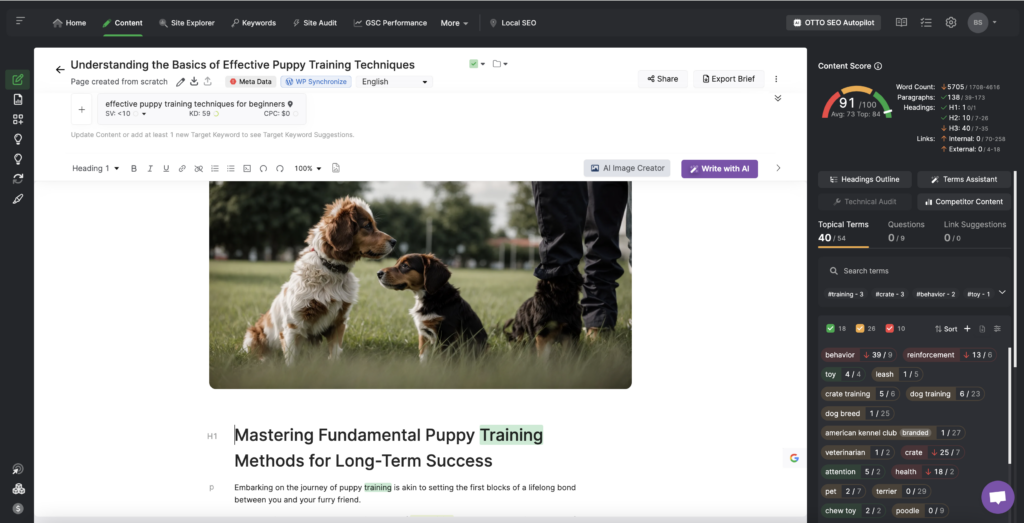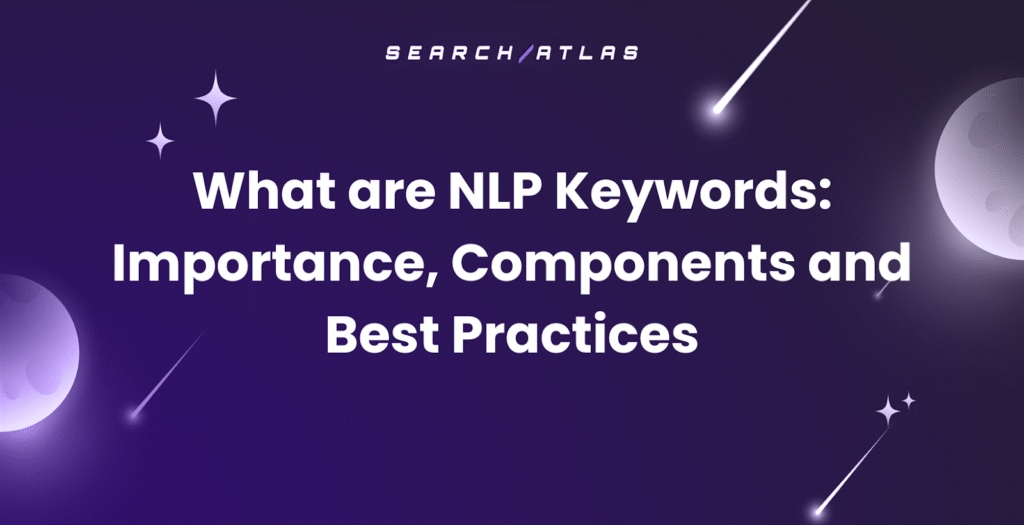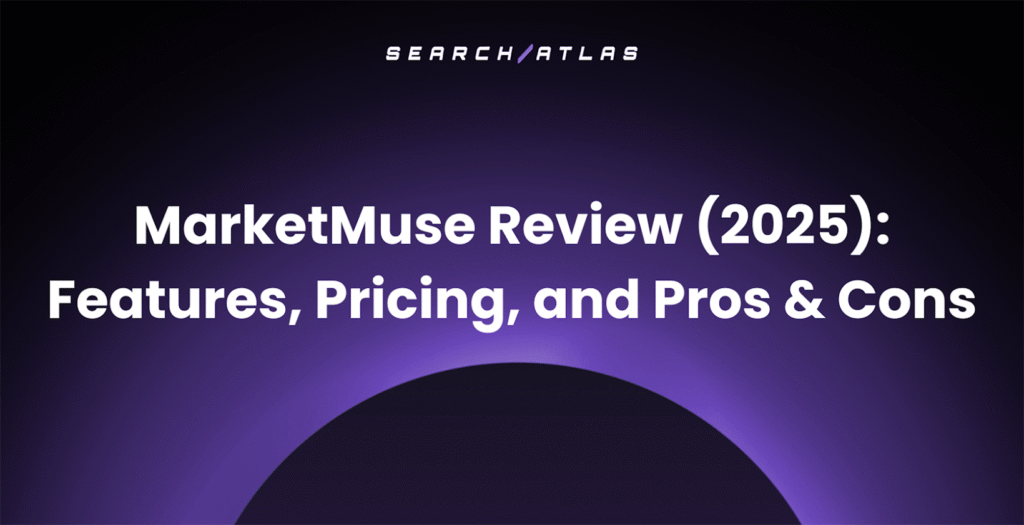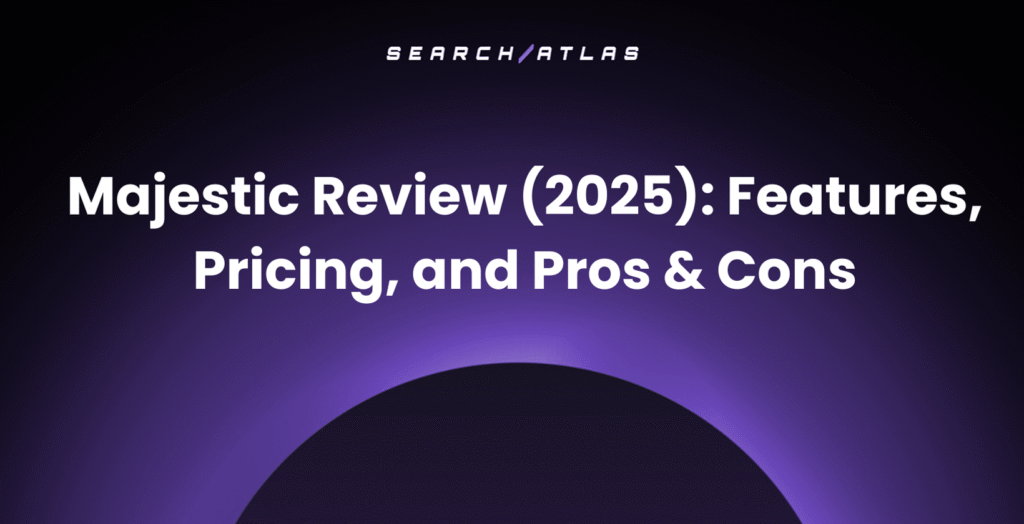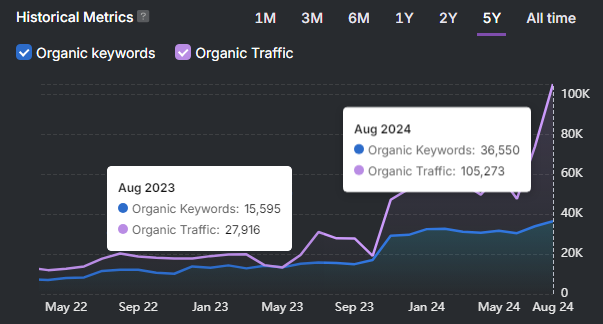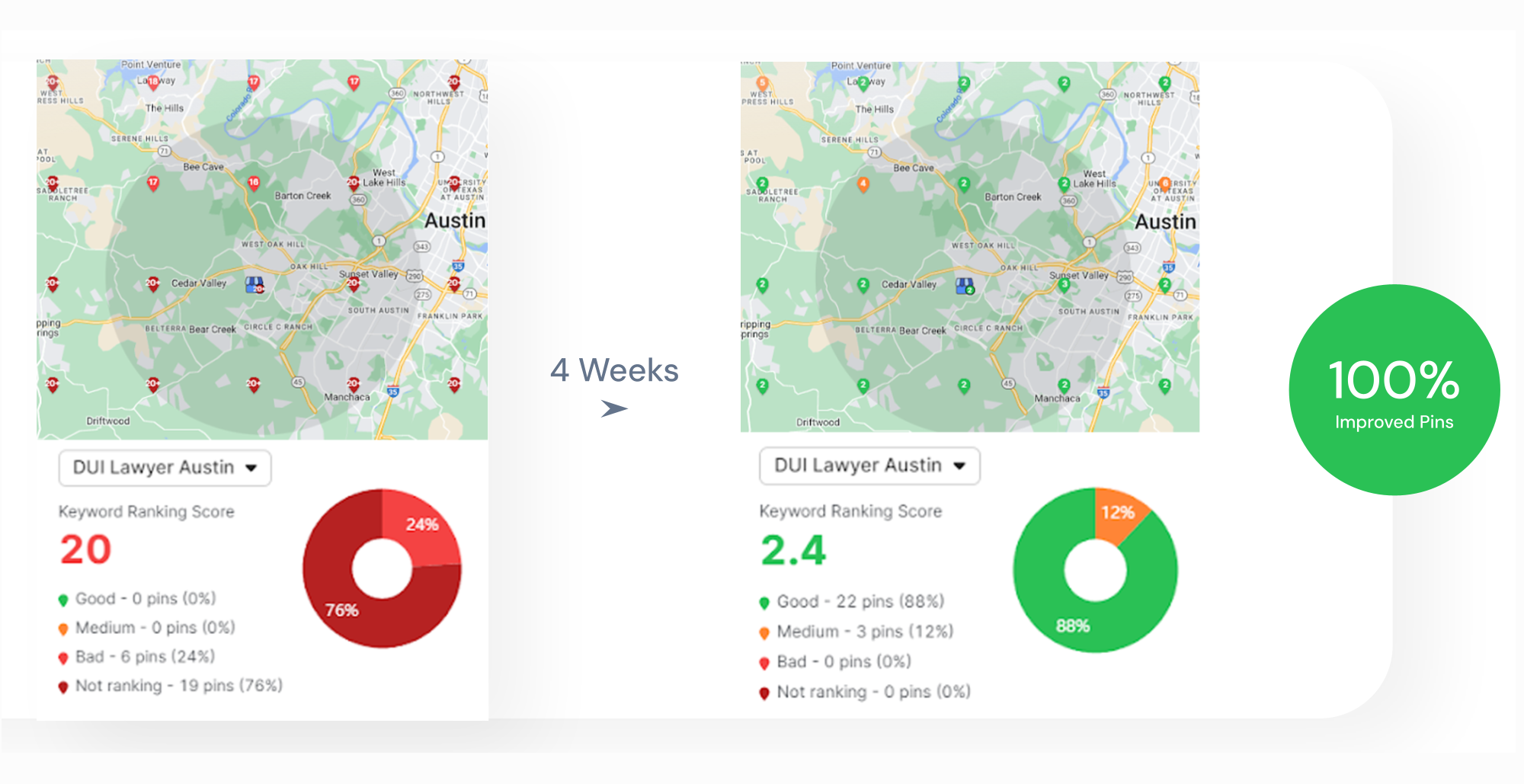SEO analysis is the process of evaluating various elements of a website to determine how well it is optimized for search engines. SEO analysis involves examining technical SEO, on-page and off-page factors, keyword performance, content quality, and user engagement to identify strengths, weaknesses, and opportunities for improvement. The importance of SEO analysis lies in its ability to guide strategic decision-making, make sure websites stay aligned with algorithm updates, and boost organic traffic and search rankings.
The four main types of SEO analysis are keyword analysis, content SEO analysis, backlink profile analysis, and competitor analysis. Each type of SEO analysis plays a key role in identifying different aspects of website performance. To conduct an SEO analysis of a website, start by checking your visibility in Google and analyzing your technical SEO and on-page SEO. Monitor keyword performance, review content quality and SEO, check internal and external links, monitor the user experience and engagement, and evaluate yourself against your competitors. This structured approach to search engine optimization analysis helps you identify actionable improvements and build a solid foundation for ongoing SEO success.
What is SEO Analysis?
SEO analysis is the process of evaluating a website to determine how well it’s optimized for search engines. SEO analysis involves examining on-page elements like meta tags, headings, and content structure, technical elements such as site speed, indexing status, and broken links, and off-page signals like backlinks and social engagement. SEO website analysis allows website owners, marketers, or SEO professionals to detect technical issues, improve user experience, and align content with search intent.
The goal of SEO analysis is to identify strengths, weaknesses, and opportunities for improvement. A comprehensive SEO analysis helps businesses make informed changes to their website to improve visibility, increase organic traffic, and maintain a competitive edge in digital search landscapes. Regular SEO analysis is essential as search algorithms, market conditions, and competitor activities continually evolve.
What is the Importance of SEO Analysis?
The importance of SEO analysis lies in its ability to provide a clear picture of how a website is performing and where it can improve. SEO analysis examines key elements such as technical issues, keyword usage, content quality, and backlink profiles to help identify both strengths and weaknesses. SEO analysis makes sure that the website aligns with current search engine algorithms and performs optimally in terms of visibility. Through these insights, website SEO analysis assists businesses in making informed decisions to refine their SEO efforts and maintain strong search engine rankings.
Additionally, SEO analysis plays a critical role in guiding effective optimization strategies. For example, discovering slow page load times, broken links, or poor mobile usability allows for technical improvements that improve both user experience and search engine favorability. Analysing SEO makes sure that content remains relevant and aligned with user intent, which is a key factor in ranking algorithms.
In addition to its impact on search engine rankings, SEO performance analysis contributes to broader digital strategy by offering insights into audience behavior, content gaps, and market trends. SEO analysis enables businesses to stay ahead of algorithm updates and shifting consumer expectations. Furthermore, regular SEO analysis provides measurable data to evaluate the effectiveness of current SEO strategies and justify future investments. In essence, a comprehensive SEO analysis is a vital diagnostic and planning tool that makes sure a website remains optimized, competitive, and aligned with long-term digital marketing goals.
What Are the 4 Types of Seo Analysis?
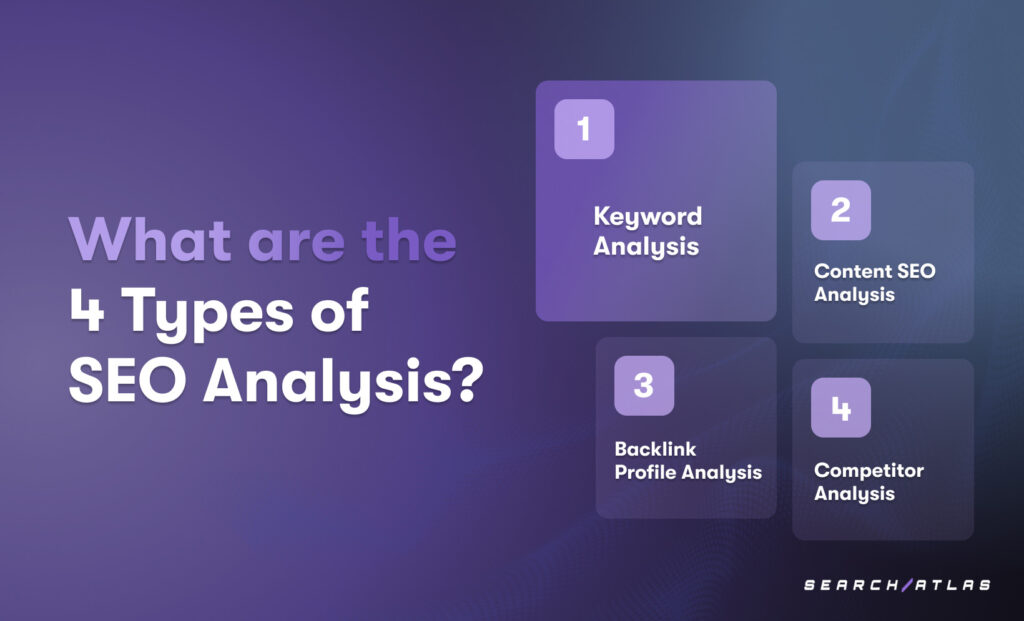
The four types of SEO analysis are keyword analysis, content SEO analysis, backlink profile analysis, and competitor analysis. Each type plays a specific role in identifying opportunities, resolving issues, and strengthening a website’s overall SEO strategy.
- Keyword Analysis. Keyword analysis involves researching and evaluating the search terms your target audience uses to find content online. Keyword analysis helps identify high-value keywords to target, analyze keyword difficulty, and understand search intent to drive relevant organic traffic.
- Content SEO Analysis. Content SEO analysis focuses on evaluating the quality, relevance, and structure of your website’s content. Content SEO analysis makes sure that content is well-optimized with the right keywords, includes clear headings, offers value to users, and aligns with what search engines prioritize.
- Backlink Profile Analysis. Backlink profile analysis examines the quantity, quality, and relevance of links pointing to your website from external sources. Backlink profile analysis helps identify toxic links that may harm rankings, opportunities for acquiring valuable new links, and how your link profile compares to competitors.
- Competitor Analysis. Competitor analysis involves reviewing your competitors’ SEO strategies, keywords, content, and backlink profiles. Competitor analysis helps identify opportunities, benchmark performance, and refine your own SEO tactics to stay ahead in your niche.
How to Do SEO Analysis of a Website?
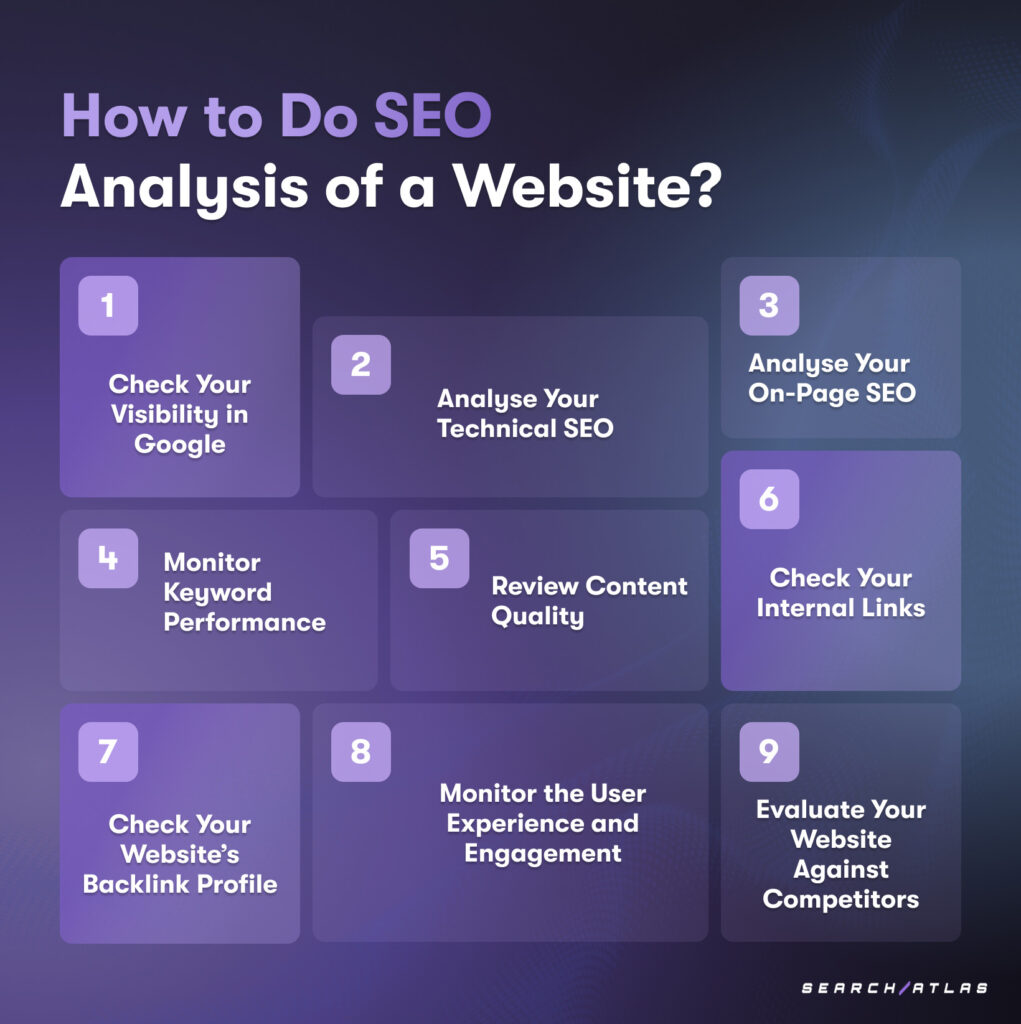
There are 9 steps to analyze a website for SEO and discover technical and content-related issues, understand where your SEO stands, and develop a strategy to improve search engine rankings and drive more organic traffic. The 9-step SEO analysis checklist is given below.
1. Check Your Visibility in Google
Checking your visibility in Google means assessing how often and where your website appears in Google’s search results for relevant queries. Checking your visibility in Google helps improve SEO by offering valuable insights into how well your website is performing in search results. Regularly checking your visibility in Google allows you to monitor which keywords you rank for, how often your pages appear in searches, and how many users click on your links. The data from regularly checking your visibility in Google helps you understand what’s working in your current SEO strategy and where adjustments are needed.
The tips on how to check your visibility in Google are given below.
- Use tools like the Search Atlas Site Explorer Tool to analyze your site’s visibility, track keyword rankings, and identify which pages are performing best in search results.
- Leverage Google Search Console to view your site’s impressions, clicks, average position, and click-through rates for different keywords and pages.
- Perform manual searches in incognito mode to see where your site ranks for specific keywords without personalized or location-based results.
- Monitor organic search traffic in Google Analytics to understand how users are arriving at your site from search engines and which pages perform best.
- Use the site search operator (e.g., site:yourdomain.com) in Google to check which of your pages are indexed and visible in search results.
The Search Atlas Site Explorer Tool provides detailed SEO metrics and competitive insights when you enter a website URL. The Search Atlas Site Explorer Tool helps assess your site’s visibility by identifying authority scores like Domain Power, Domain Authority, and Domain Rating, along with organic and paid traffic data. Additionally, the Search Atlas Site Explorer Tool tracks keyword rankings, backlink profiles, spam scores, and URL ratings to offer a comprehensive view of your website’s performance.
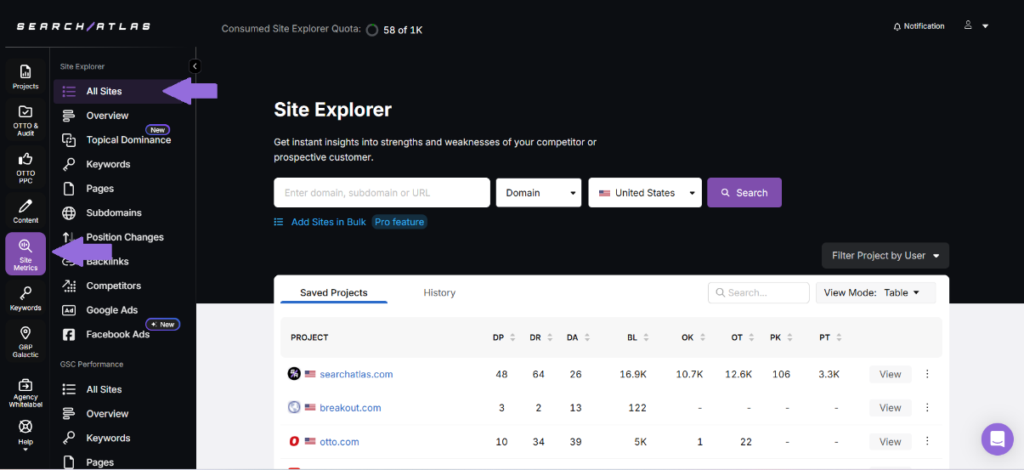
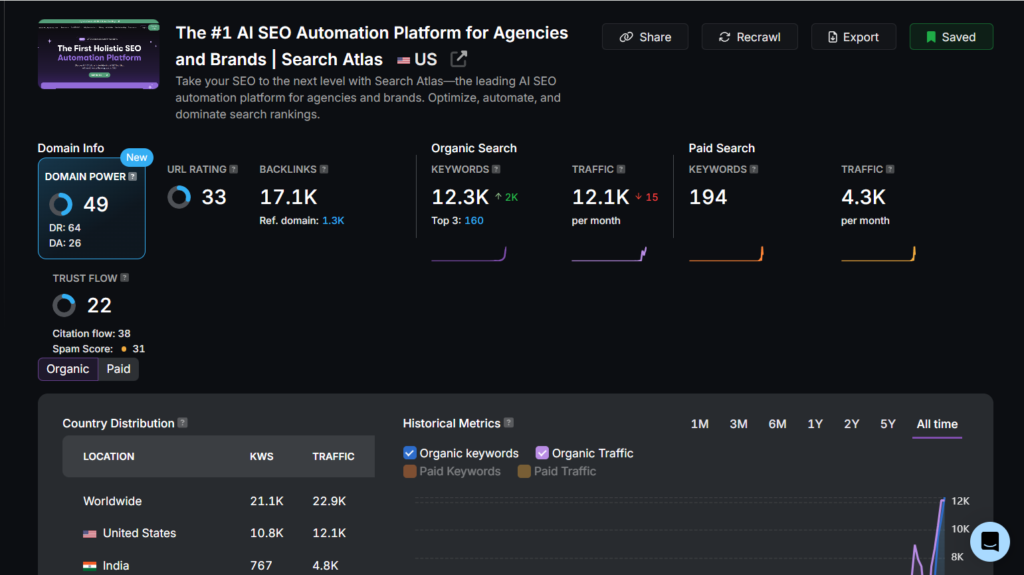
2. Analyse Your Technical SEO
Analyzing your technical SEO involves evaluating the backend elements of your website that affect how search engines crawl, index, and rank your pages. Analyzing your technical SEO includes assessing factors like site speed, mobile-friendliness, crawlability, indexing status, structured data, and URL structure. Regularly analyzing your technical SEO helps improve your overall SEO strategy by revealing hidden issues that may prevent search engines from effectively crawling and indexing your website. An analysis of your technical SEO provides a deeper understanding of how search engines interact with your site’s structure, speed, mobile compatibility, and internal linking.
Use the Search Atlas Site Auditor Tool to identify crawl errors, indexing issues, and core web vitals performance. Check page speed performance using Google PageSpeed Insights or GTmetrix to assess how your site loads across devices. Validate structured data using Google’s Rich Results Test to make sure schema markup is correctly implemented and error-free. Monitor your robots.txt file and XML sitemap to make sure they are accessible, up to date, and correctly guiding search engines. Review canonical tags and redirect chains to identify potential indexing and duplication issues.
The Search Atlas Site Auditor Tool provides a detailed overview of your website’s technical performance by identifying issues related to crawlability, indexability, and site structure. Simply enter your domain, set the maximum number of pages to crawl, configure the crawl frequency, and click “Start Audit.” The Search Atlas Site Auditor Tool then scans your pages and highlights the most critical SEO issues using customizable Page Explorer reports. The Search Atlas Site Auditor Tool allows you to combine crawl data with metrics from Google Search Console and Google Analytics to help you quickly identify problems on your most important landing pages. This type of targeted, data-driven analysis makes sure your website’s technical foundation is solid and supports better search visibility and long-term SEO success.

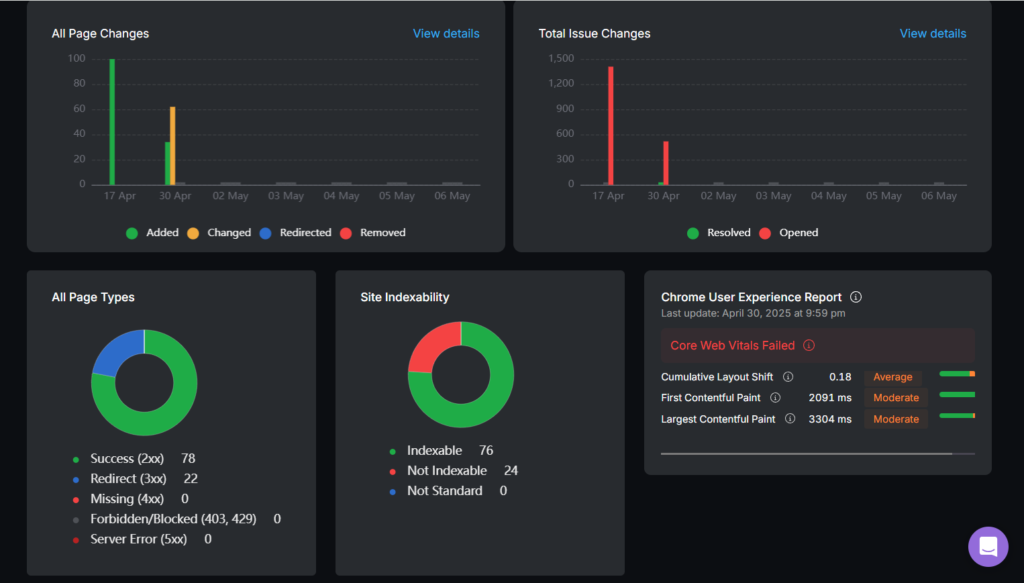
3. Analyse Your On-Page SEO
Analyzing your on-page SEO involves evaluating the elements directly on your website’s pages that affect search engine rankings and user experience. Analyzing your on-page SEO includes examining elements such as title tags, meta descriptions, header tags, URL structure, internal linking, image optimization, and the overall quality and relevance of the content.
Conducting a thorough on-page SEO analysis helps improve SEO by revealing weaknesses in keyword targeting, content alignment, and HTML tag usage. A comprehensive on-page SEO analysis makes sure that your content matches user intent, which is a key ranking factor, and helps search engines clearly understand what each page is about. Additionally, regular on-page SEO analysis highlights duplicate content, missing metadata, or poorly structured pages that may be hurting your rankings.
To analyze your on-page SEO, start by reviewing your title tags and meta descriptions to make sure they are unique, compelling, and contain target keywords. Check that your headers (H1, H2, etc.) are used logically to structure content and include relevant terms. Evaluate URL structures for clarity and keyword inclusion, and assess internal linking to make sure important pages are easily discoverable. Use tools like the Search Atlas On-Page Audit Tool to automate this process and uncover specific on-page issues.
The Search Atlas On-Page Audit Tool uses powerful analytical data to provide detailed feedback on your content’s performance based on targeted keywords. The Search Atlas On-Page Audit Tool assesses your page’s structure to look into optimization opportunities to improve its visibility, relevance, and user experience. Additionally, the Search Atlas On-Page Audit Tool helps you easily compare your content score, word count, and readability against top-ranking content to help you make informed improvements to boost your search visibility.
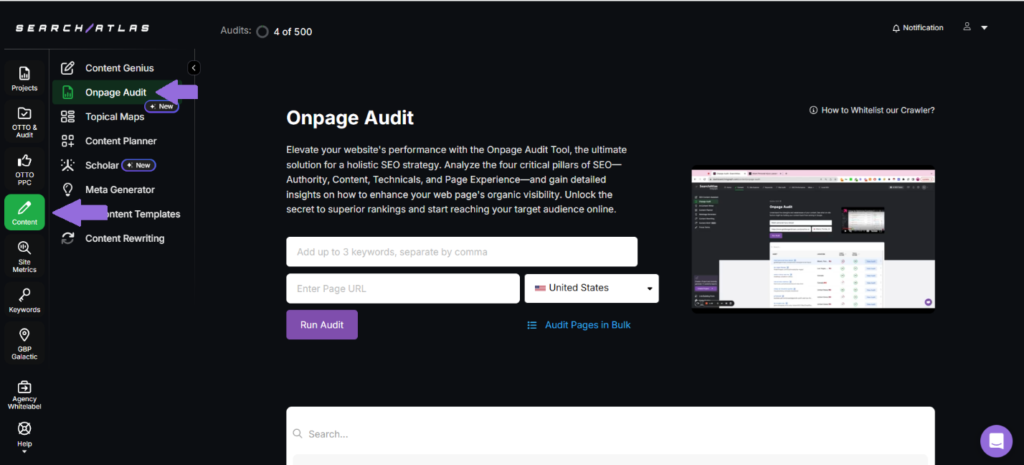
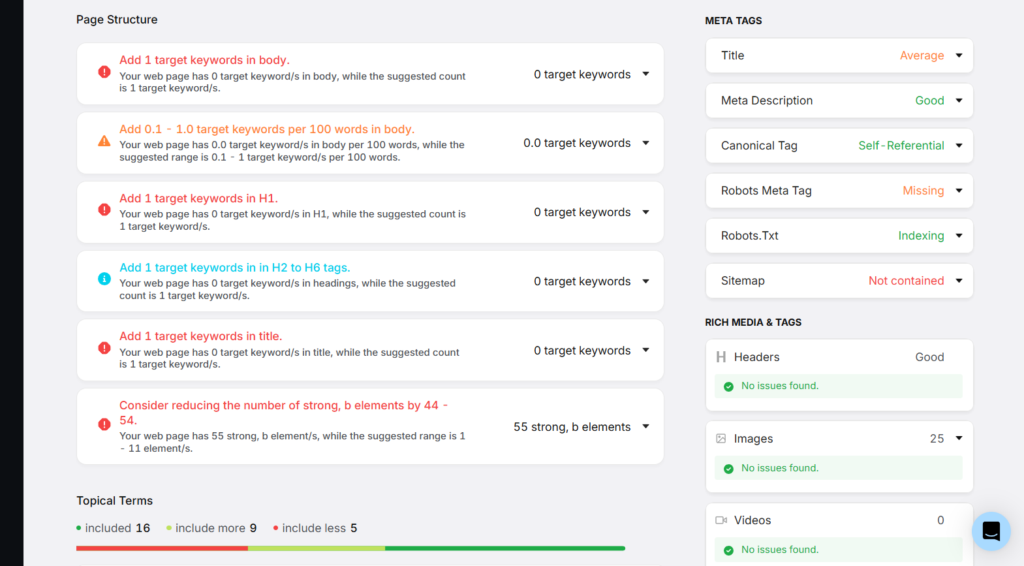
4. Monitor Keyword Performance
Monitoring keyword performance involves tracking how your chosen keywords are ranking in search engine results over time, as well as how much traffic, engagement, and conversions they generate. Monitoring keyword performance improves SEO by allowing you to respond quickly to ranking changes, capitalize on rising search trends, and adjust your content to maintain or improve visibility. Tracking keyword performance helps make sure your website remains competitive by identifying which keywords are driving valuable traffic and which ones may need more optimization. Additionally, regularly tracking performance assists in evaluating the ROI of your SEO efforts and in identifying gaps where new content could target untapped or declining keywords.
Use tools like the Search Atlas Keyword Rank Tracker Tool to track keyword rankings regularly and identify upward or downward trends early. Track both primary and long-tail keywords, observe how they perform on key landing pages, and analyze their impact on traffic and conversions. Analyze which pages rank for each keyword to guarantee content relevance and optimization. Use the Search Atlas Keyword Research Tool to keep an eye on emerging keyword opportunities and declining terms to adjust your strategy proactively. Compare keyword performance against competitors to identify content gaps and potential ranking opportunities.
The Search Atlas Keyword Rank Tracker Tool automatically checks the rankings of your target keywords at your chosen frequency and provides insights into key metrics, including current position, search volume, SERP features, and ranking trends over time, to help you evaluate your keyword performance and adjust your SEO strategy accordingly. Additionally, the Search Atlas Keyword Rank Tracker Tool provides a detailed overview of the number of keywords your competitors have in the top 10 and the rate of their search visibility to help you identify content gaps and possible ranking opportunities.
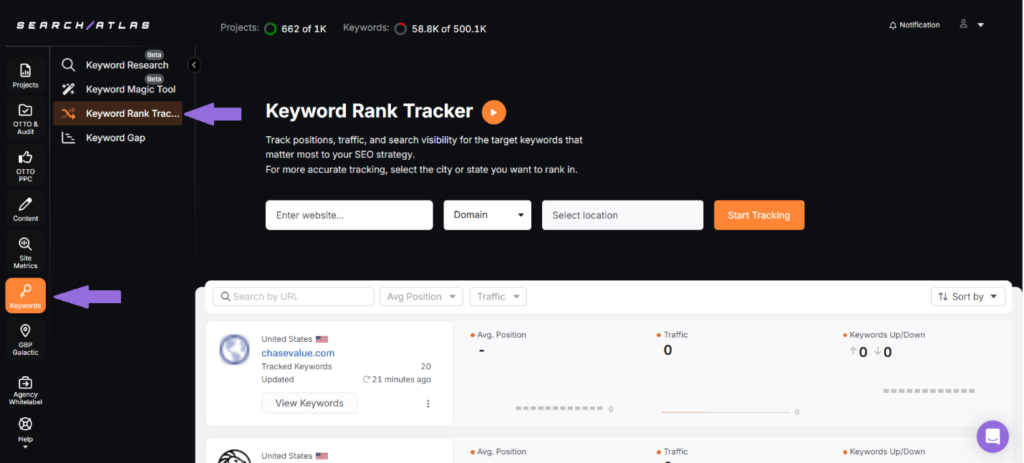
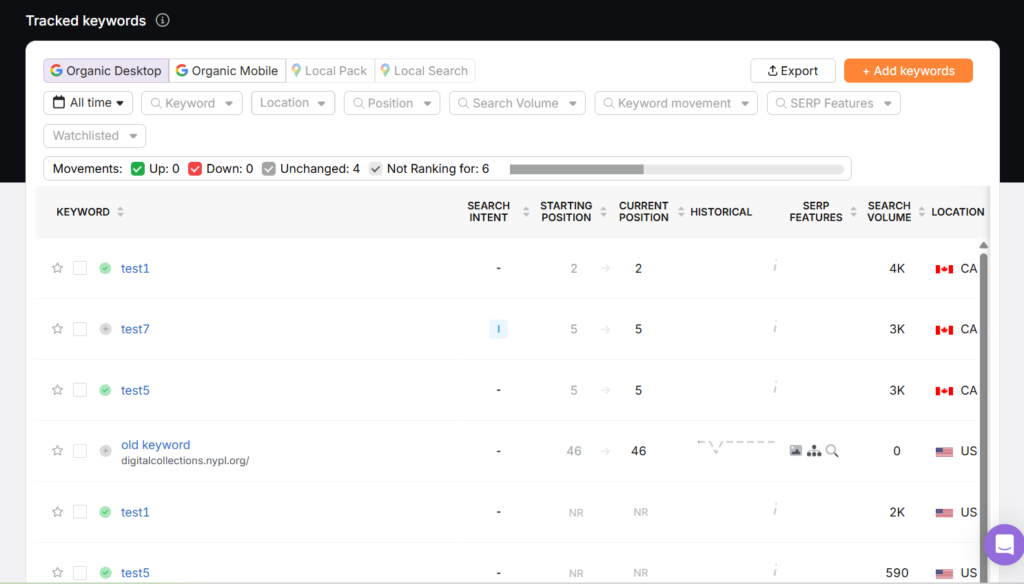
The Search Atlas Keyword Research Tool helps you identify emerging keyword opportunities to help you stay ahead of SEO trends and capture traffic early in the search cycle. The Search Atlas Keyword Research Tool provides comprehensive insights into key metrics such as search volume, cost-per-click (CPC), keyword difficulty, top-ranking pages, and related keyword suggestions. Additionally, the Search Atlas Keyword Research Tool empowers you to explore keyword variations, semantically related terms, and commonly asked questions to help you build a more targeted, high-performing SEO strategy.
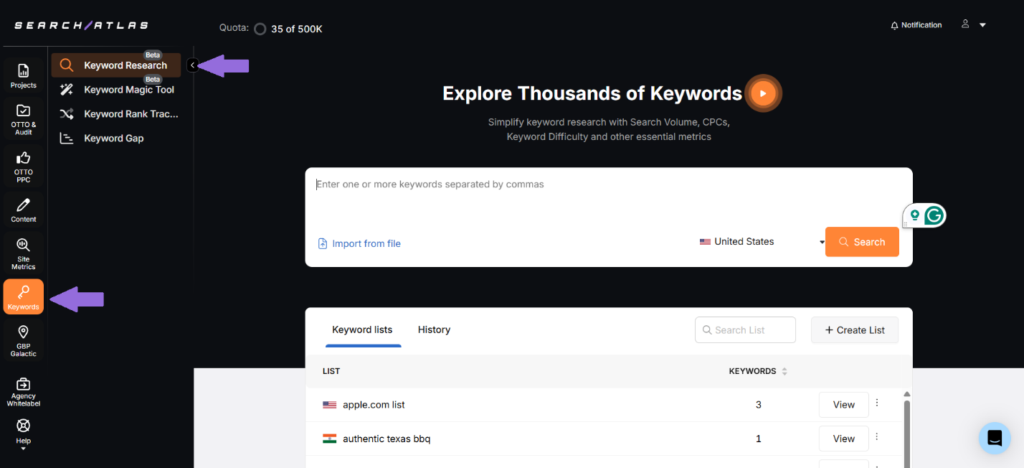
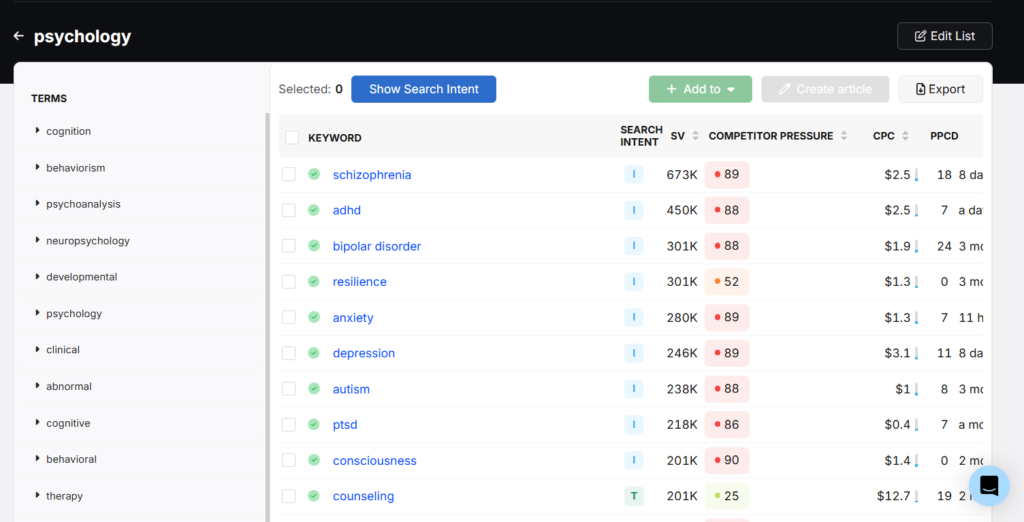
5. Review Content Quality and SEO
Reviewing content quality and SEO involves evaluating how well your website’s content meets user intent while aligning with search engine optimization best practices. Reviewing content quality and SEO includes assessing readability, keyword relevance, originality, structure, accuracy, and how engaging and informative the content is for the intended audience. Evaluating content quality and SEO helps improve your search visibility by making sure that each piece of content attracts users and satisfies search engine criteria. Additionally, regularly reviewing content quality and SEO makes sure that the content remains up to date, adds value, and supports your overall SEO goals through strategic keyword use and internal linking.
The tips for reviewing content quality and SEO are listed below.
- Make sure each page has a clear purpose and satisfies specific search intent.
- Check that the content is original, accurate, and regularly updated.
- Evaluate your content’s readability and structure using tools like the Search Atlas On-Page Audit Tool and the Search Atlas Scholar Tool.
- Verify factual accuracy by cross-checking data, statistics, and claims with reputable sources.
- Verify proper keyword usage without overstuffing and ascertain natural integration.
- Inspect internal and external linking to make sure they are functional and relevant, and point to authoritative sources.
- Examine multimedia use (images, videos, charts) to determine if they support and improve the textual content.
The Search Atlas Scholar Tool grades your content against Google’s Page Quality Algorithm and information retrieval principles and provides clear, actionable insights to help you improve content quality and search performance. To review your content using the Search Atlas Scholar Tool, simply enter your target keyword, upload your content, URL, or draft, and click “Analyze Page.” The Search Atlas Scholar Tool will then assess your content from all angles and generate a data-driven score, highlighting specific areas for optimization.
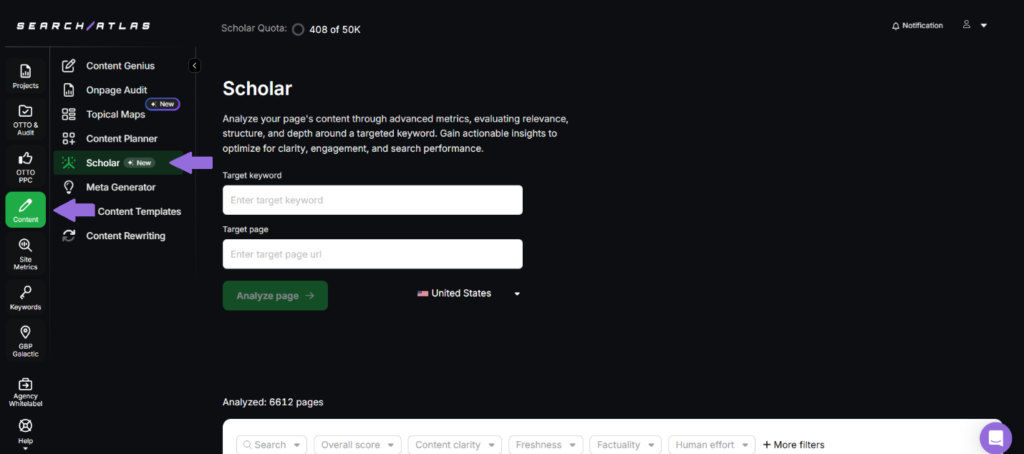
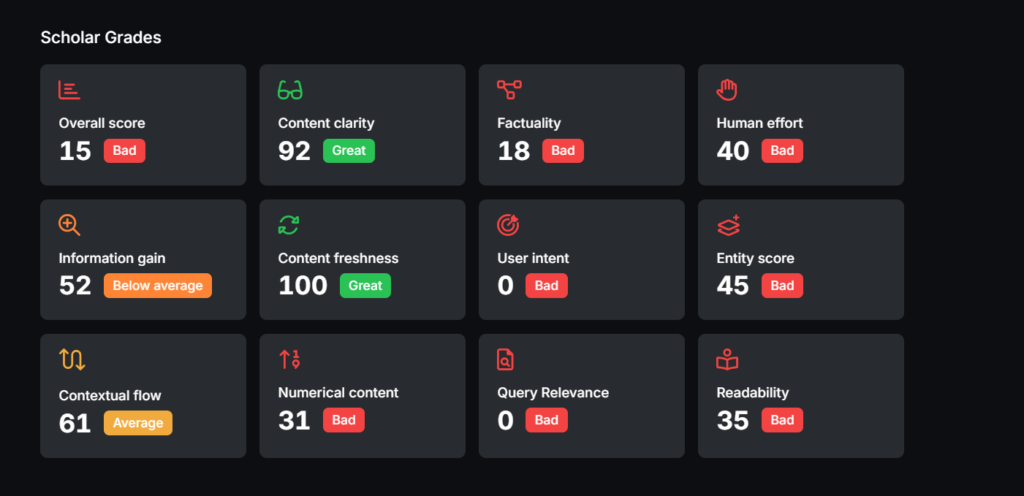
Additionally, the Search Atlas On-Page Audit Tool evaluates your content quality and SEO by analyzing key elements such as content score, word count, and readability. The Search Atlas On-Page Audit Tool allows you to compare your page against the top 10 ranking competitors for your target keyword to identify the areas where your content may fall short and need improvement. With detailed insights and guidance, The Search Atlas On-Page Audit makes sure your content is relevant and engaging and aligns with what search engines prioritize to help you improve visibility, boost rankings, and better connect with your target audience.
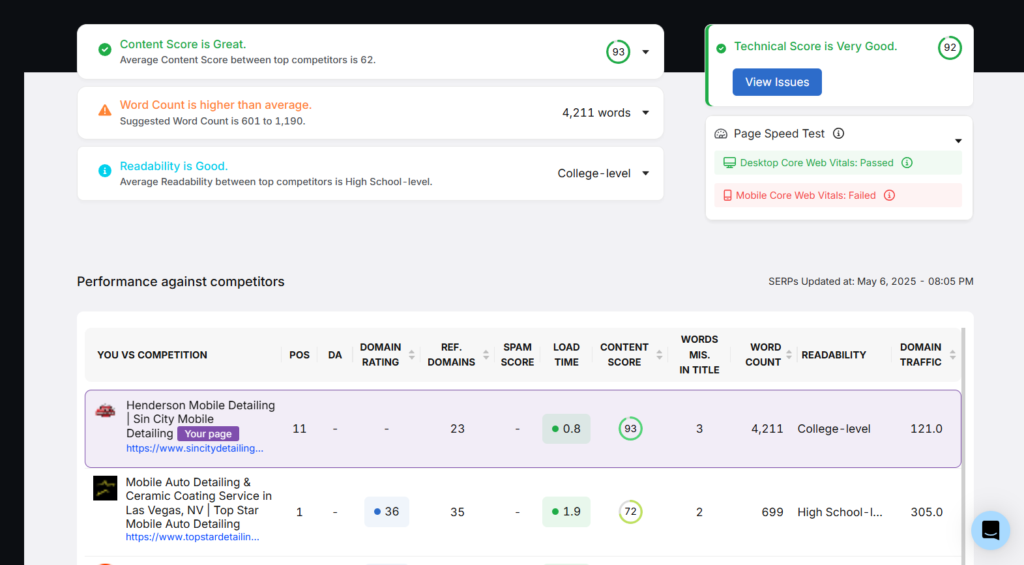
6. Check Your Internal Links
Checking your internal links involves reviewing the hyperlinks that connect one page of your website to another within the same domain. Checking your internal links improves SEO by making sure that search engines can effectively crawl and index your site, while helping users discover more relevant information. Monitoring internal links prevents broken links that waste crawl budget and frustrate users, maintains the flow of link equity throughout your site, guarantees complete crawlability of your content, and improves user engagement metrics that search engines value. Additionally, regular link audits help identify orphaned content, optimize anchor text, strengthen topical relevance between related pages, and maintain a logical site hierarchy that search engines can easily understand.
The tips for checking internal links are given below.
- Run regular internal link audits using tools like the Search Atlas On-Page Audit Tool to identify broken, redirected, or orphaned links.
- Click through links manually on key pages to check if they direct users to the correct and intended destination.
- Check for orphaned pages and make sure every important page is linked from at least one other relevant page.
- Review anchor text to make sure it’s descriptive, relevant, and not over-optimized with exact-match keywords.
- Avoid including too many links that can dilute link equity and confuse users.
- Make sure links appear naturally within the content rather than being crammed into footers or sidebars.
- Monitor internal link depth, aiming to keep important content no more than 3 clicks away from the homepage.
- Ascertain consistency, especially in URL formats (e.g., avoiding mixing www and non-www or HTTP and HTTPS).
- Fix redirect chains or loops, which can hurt crawl efficiency and user experience.
The Search Atlas On-Page Audit Tool serves as an effective way to check and optimize internal linking across your website. The Search Atlas On-Page Audit Tool helps identify broken links that disrupt user experience, orphaned pages that are not linked from any other part of your site, and redirect chains that can waste crawl budget and slow down site performance.
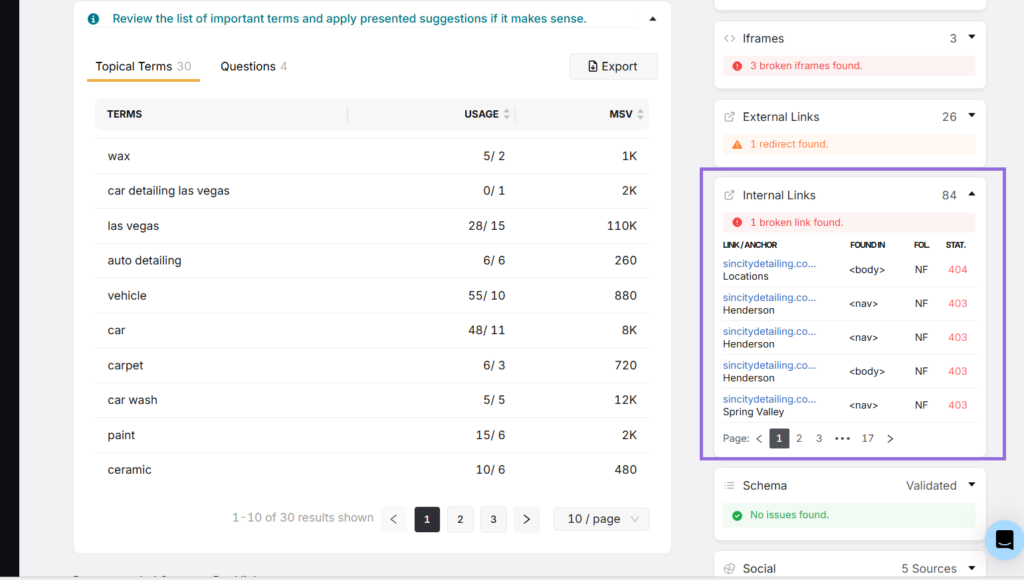
Additionally, the Search Atlas On-Page Audit Tool provides internal linking recommendations to strengthen your site’s structure by improving navigation, increasing crawlability, and guaranteeing better distribution of link equity.

7. Check Your Website’s Backlink Profile
Checking your website’s backlink profile involves reviewing the external sites that link to your pages. Checking your website’s backlink profile improves SEO by making sure your site maintains a healthy and authoritative presence online. Regularly checking your backlink profile helps you assess the effectiveness of your link-building strategy and spot any potential issues, such as spammy links or negative SEO attacks. By maintaining a clean and diverse backlink profile, you can increase your site’s credibility, improve rankings, and attract more organic traffic.
The tips for checking your website’s backlink profile are outlined below.
- Use tools like the Search Atlas Backlink Research Tool to analyze the quantity, quality, and diversity of your backlinks.
- Monitor toxic backlinks regularly and disavow harmful or spammy links that could negatively affect your SEO performance.
- Assess the authority of linking domains, making sure they are reputable and relevant to your niche.
- Evaluate anchor text to make sure it is varied and natural, avoiding overuse of exact-match keywords.
- Track new backlinks to stay updated on the growth of your backlink profile and identify high-value linking opportunities.
- Use tools like the Search Atlas Backlink Profile Comparison Tool to compare your backlink profile against competitors and discover gaps and opportunities in your SEO strategy.
- Distribute backlinks across key pages (blogs, product pages, landing pages) for a balanced and effective link profile.
- Review the context and relevance of backlinks to make sure they contribute to your site’s overall topical authority and relevance.
The Search Atlas Backlink Research Tool helps you to analyze and understand the backlink profile of any website, page, or subdomain. The Search Atlas Backlink Research Tool provides detailed insights into both domain-level and page-level metrics. The Search Atlas Backlink Research Tool identifies linking domains, linking pages, anchor text distribution, and tracks new or lost backlinks as well as potential spam links to help you discover link-building opportunities, monitor backlink health, and strengthen your site’s authority and search visibility.
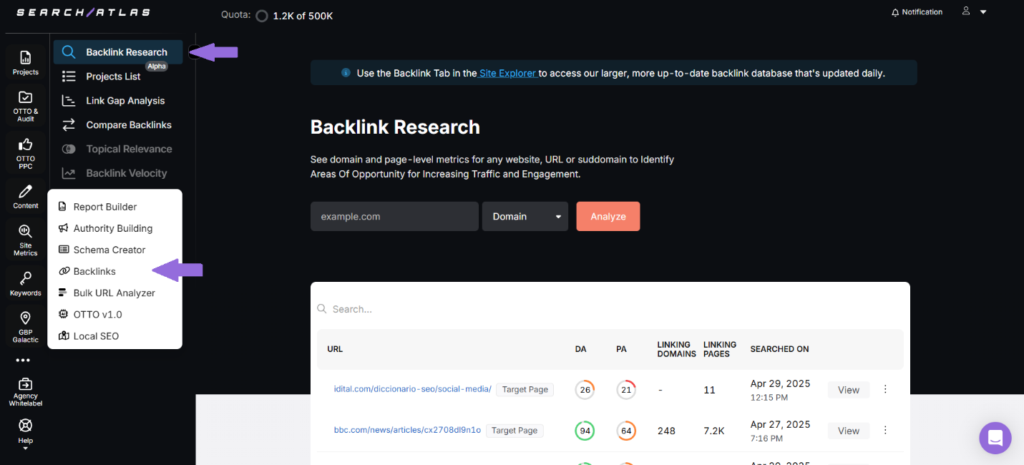

The Search Atlas Backlink Profile Comparison Tool allows you to compare your website’s backlink profile with up to six competitors side by side. The Search Atlas Backlink Profile Comparison Tool analyzes essential SEO metrics such as Domain Authority, Page Authority, total linking pages, linking domains, and more to help you identify gaps, evaluate your competitive standing, and uncover opportunities to strengthen your link-building strategy.
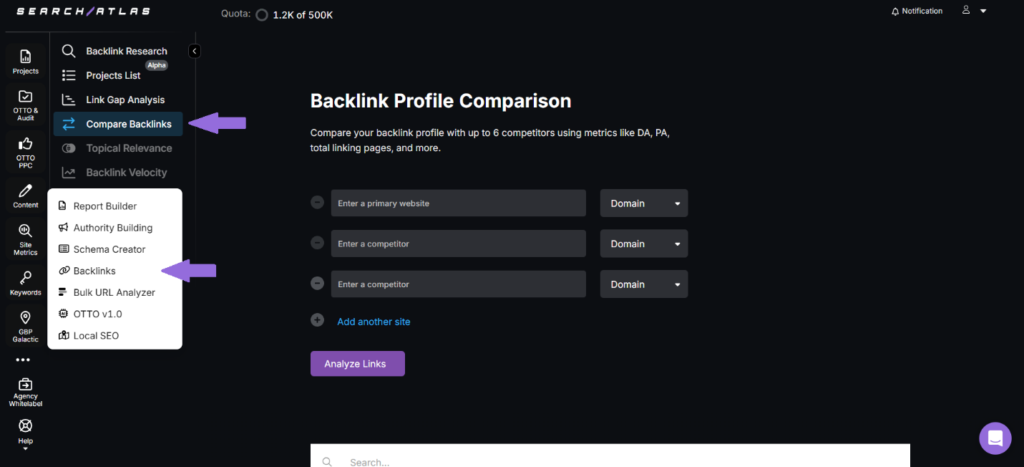
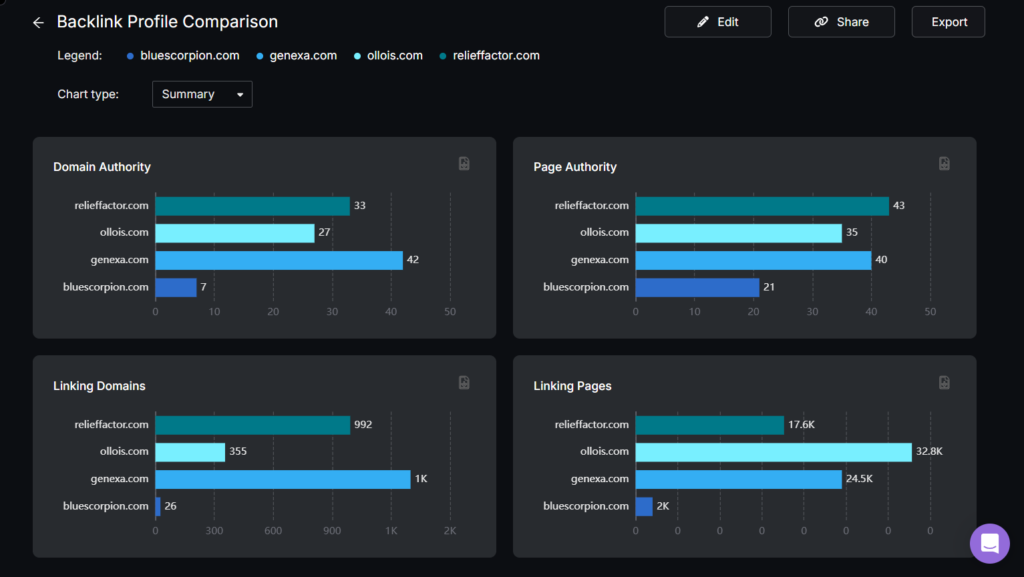
8. Monitor the User Experience and Engagement
Monitoring the user experience and engagement means evaluating how visitors interact with your website, including how easily they can navigate, how long they stay, and how effectively they find what they need. Monitoring the user experience and engagement involves analyzing metrics like bounce rate, average session duration, page views, and user behavior patterns to understand how engaging and user-friendly your site is.
Assessing the user experience and engagement helps improve SEO by making sure that visitors have a smooth, satisfying interaction with your website, which search engines increasingly prioritize when ranking pages. When users stay longer on your site, navigate multiple pages, and interact meaningfully with your content, it signals to search engines that your site provides value, which can lead to higher rankings. Additionally, regularly monitoring user experience and engagement helps identify and resolve issues like high bounce rates, poor mobile usability, or slow-loading pages, reducing frustration and improving the overall user journey.
Use tools like Google Analytics or Microsoft Clarity to track user interactions and engagement metrics. Monitor key engagement indicators such as bounce rate, average session duration, pages per session, and exit rates. Analyze heatmaps and session recordings to visually understand where users click, scroll, or drop off on your pages. Set up goal tracking and conversion funnels to monitor how users navigate your site and whether they complete desired actions. Identify and address friction points in the user journey to improve satisfaction and encourage deeper engagement. Continuously test and optimize elements like page layout, CTAs, and content structure to improve usability and interaction.
Consistently tracking and improving user experience and engagement helps you keep visitors satisfied while improving their interaction with your site. Regularly monitoring the user experience and engagement helps build a strong foundation for long-term SEO success because a positive experience encourages repeat visits, deeper engagement, and increased trust.
9. Evaluate Your Website Against Competitors
Evaluating your website against competitors involves comparing your website’s SEO performance to that of businesses in your niche. Evaluating your website against competitors helps improve SEO by revealing gaps in your content, backlinks, and keyword strategies. Reviewing your SEO performance in comparison to your competitors allows you to understand what is working for your competitors, which tactics are driving their organic and paid traffic, and how you can adapt your strategy to outperform them. Additionally, benchmarking your performance against your competitors helps refine your SEO approach, making it more targeted and effective in driving better rankings and increasing organic traffic.
The best practices for evaluating your website against your competitors are outlined below.
- Identify your top SEO competitors using tools like the Search Atlas Site Explorer Tool.
- Analyze competitors’ organic and paid traffic to understand where their traffic is coming from and which keywords or ads are driving it.
- Compare domain-level metrics such as Domain Power, Domain Authority (DA), and Domain Rating (DR) to assess the relative authority of your site.
- Use tools like the Search Atlas Link Gap Analysis Tool to compare your backlink profile with your competitors and identify link-building gaps and opportunities.
- Review competitors’ keyword rankings to discover high-performing keywords you may have missed.
- Track their content update frequency and content depth to benchmark your own content strategy.
- Use the Topical Dominance tab within the Search Atlas Site Explorer Tool to benchmark your site’s topical authority against your competitors.
- Conduct regular audits to monitor changes in competitor strategies and stay proactive in adjusting your own approach.
The Search Atlas Site Explorer Tool’s Competitors tab helps you identify your top online competitors and evaluate their competitive positioning based on key SEO metrics such as organic keywords and organic traffic. Simply enter your domain and target country and click “Search.” The Search Atlas Site Explorer Tool’s Competitors tab helps you better understand where you stand in relation to other players in your niche, helping you shape more effective SEO and content strategies.
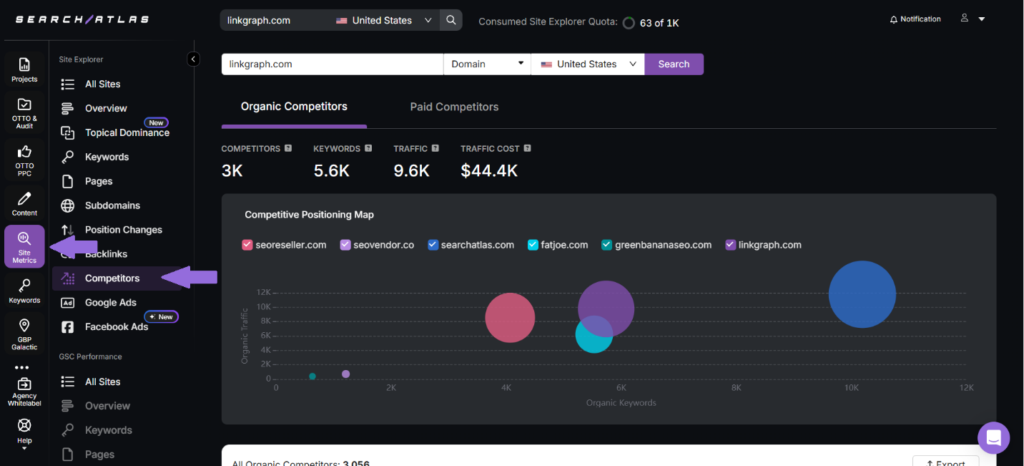
The Search Atlas Link Gap Analysis Tool helps you identify the backlink gap between your website and competitors. The Search Atlas Link Gap Analysis Tool provides you with a list of websites, their Domain Authority scores, spam scores, and the top linking page for each competitor.
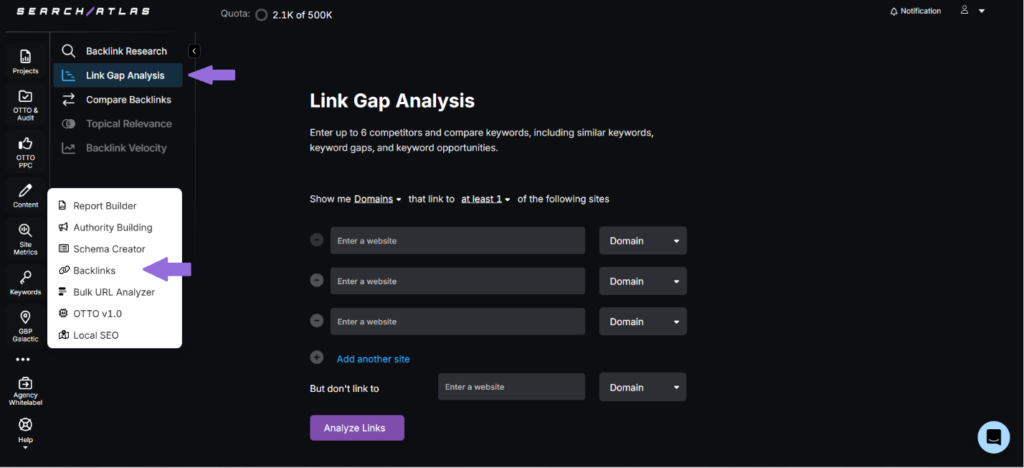
The Topical Dominance tab within the Search Atlas Site Explorer Tool helps you compare your website’s topical authority against competitors for specific subject areas. Simply enter your domain and a competitor’s, and the Search Atlas Site Explorer Tool’s Topical Dominance tab analyzes and scores how well each site covers various topics, highlighting strengths and gaps. Additionally, the Search Atlas Site Explorer Tool’s Topical Dominance tab pinpoints content areas where your site is underperforming, allowing you to refine your strategy.
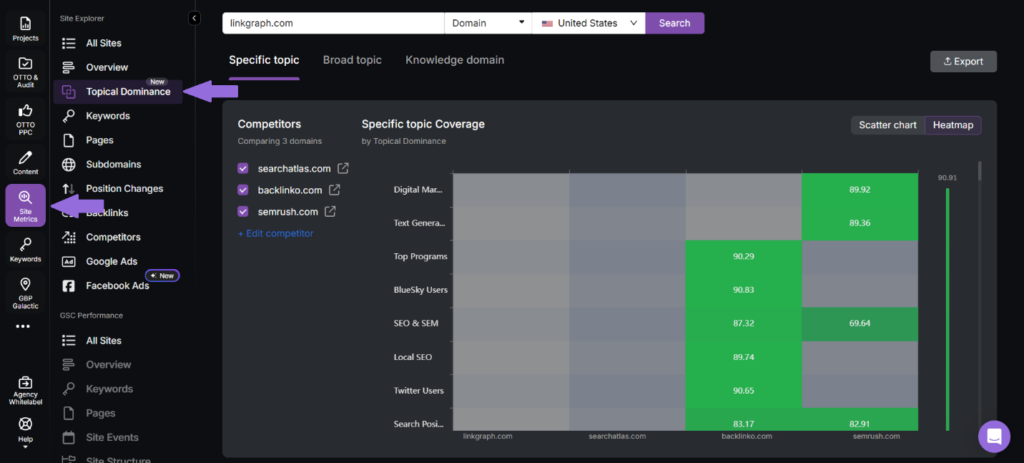
How to Automate SEO Analysis Process Using Otto SEO?
Automating the SEO analysis process using the Search Atlas Otto SEO Tool makes website optimization more efficient by handling technical, on-page, and off-page SEO tasks with minimal manual effort. To get started, you just need to add the Otto pixel, which is a small code snippet, to your website’s header. The Otto pixel grants Otto SEO the access needed to analyze your site’s structure and content.
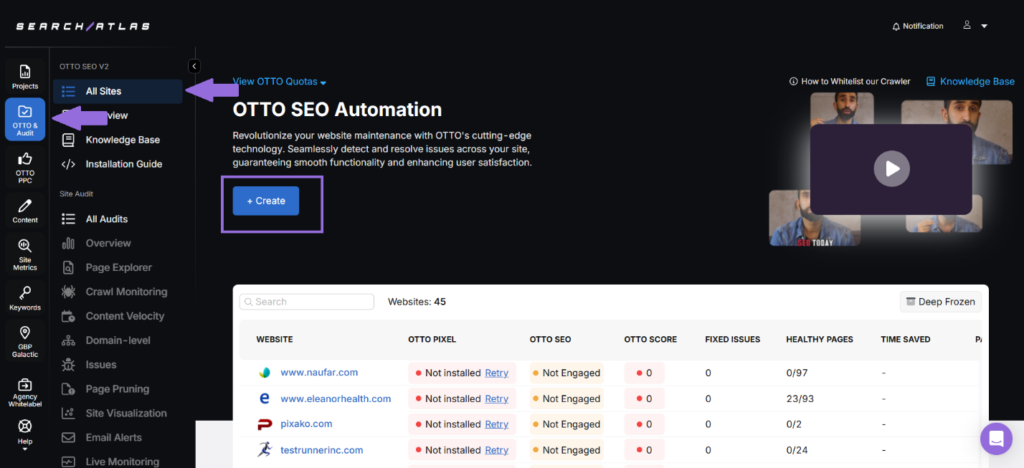
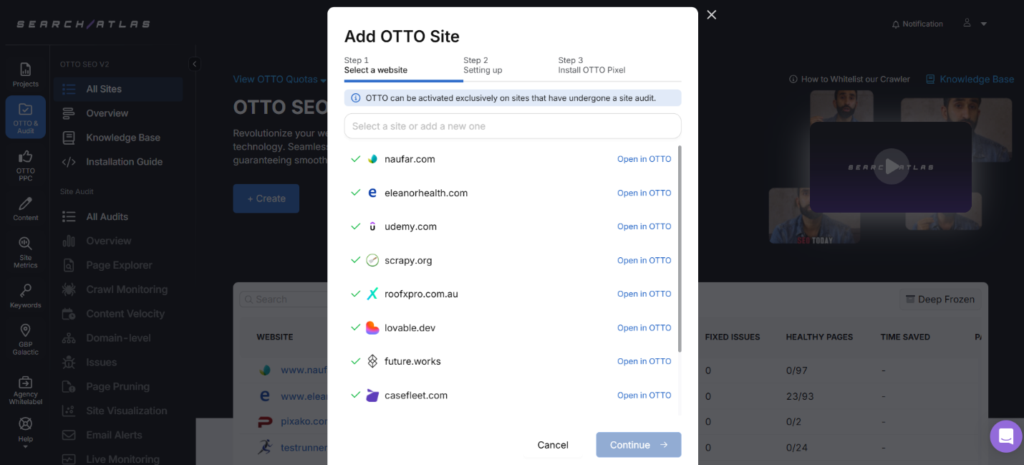
Once enabled, the Search Atlas Otto SEO Tool conducts an in-depth audit of your website, examining technical SEO signals as well as strategic SEO factors. The Search Atlas Otto SEO Tool analyzes your site against Search Atlas’s Holistic SEO blueprint, which is a comprehensive framework based on modern best practices, to make sure you are not just fixing issues, but aligning your website with search engine expectations for long-term visibility. Additionally, the Search Atlas Otto SEO Tool integrates data from your Google Search Console to analyze live performance metrics, such as keyword rankings, click-through rates, impressions, and page indexing issues, and generate highly tailored and actionable optimization suggestions.
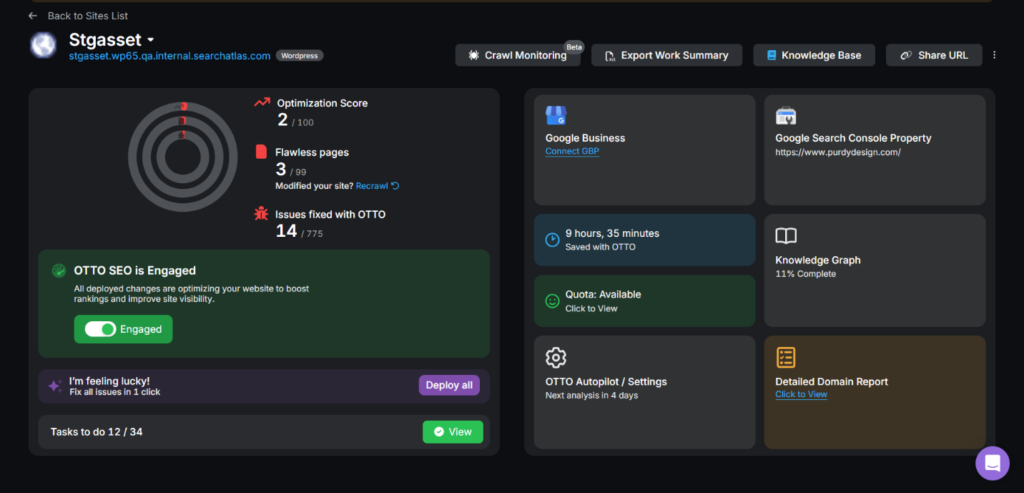
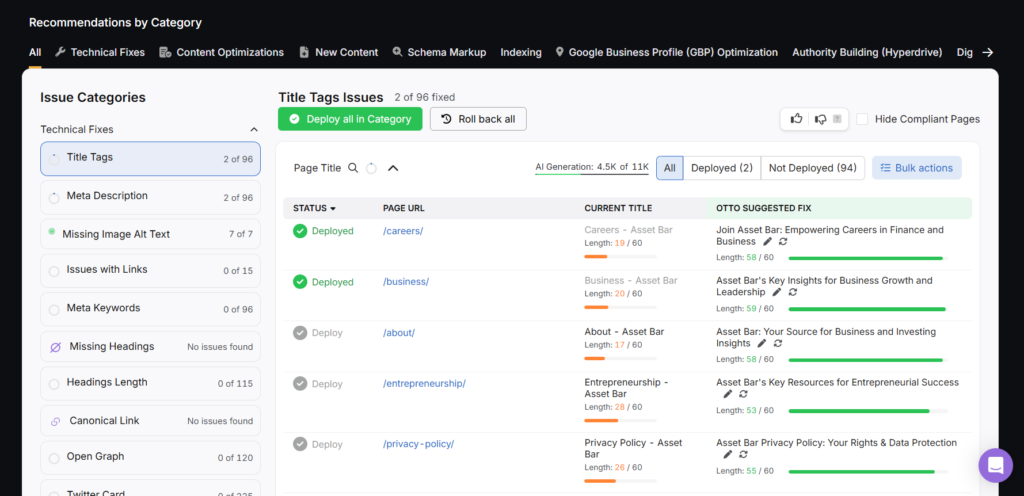
What makes the Search Atls Otto SEO Tool unique is its ability to automatically implement these optimization suggestions with a single click, regardless of your CMS. After reviewing the recommendations, you can choose which ones to apply, and Otto SEO will handle the updates directly on your website, giving you full control without needing to make changes manually.
Additionally, the Search Atlas Otto SEO Tool provides ongoing monitoring of your website. As your site structure or performance changes, or as new search trends emerge, the Search Atlas Otto SEO Tool updates its recommendations accordingly to make sure that your SEO strategy stays current without constant manual tracking.
By automating SEO analysis with the Search Atlas Otto SEO Tool, you significantly reduce time spent on repetitive tasks, avoid overlooking critical issues, and maintain strong site health. The automated SEO analysis enables faster execution of optimizations and makes sure your site is always positioned for long-term visibility and success in search results.
What Tools to Use for SEO Analysis?
There are various tools to use for SEO analysis and to make sure your website is visible and highly competitive in SERPs. Free tools like Google Search Console help track how your website appears in search results and provide insights into keyword rankings, click-through rates, indexing status, mobile usability, and search performance across pages. Google Analytics complements this by offering detailed user behavior data, such as bounce rate, session duration, conversion paths, and traffic sources, helping you assess how users interact with your site. Additionally, Google PageSpeed Insights focuses specifically on performance by evaluating loading times and suggesting improvements that improve both user experience and search rankings.
The Search Atlas SEO Software Platform, on the other hand, provides a more advanced and integrated toolkit for deep SEO analysis and optimization. The Search Atlas Site Explorer Tool gives a complete overview of any domain’s SEO metrics, including authority scores like Domain Rating and Trust Flow, organic and paid keyword rankings, backlink profiles, spam scores, and traffic estimates. The Search Atlas Site Auditor Tool checks for crawl errors, indexing issues, broken links, and site structure problems, offering actionable recommendations to improve site health.
The Search Atlas On-Page Audit Tool zooms in on individual pages, analyzing internal linking, heading structure, keyword placement, and metadata to fine-tune on-page SEO. The Search Atlas Keyword Research Tool helps identify valuable search terms using real-time data, showing metrics such as difficulty scores, volume, and traffic potential. Meanwhile, the Search Atlas Keyword Rank Tracker Tool lets you monitor keyword rankings over time, helping you stay on top of your performance in SERPs.
The Search Atlas Scholar Tool grades your content across multiple dimensions to help you align your writing with what Google deems authoritative, trustworthy, and relevant. The Search Atlas Backlink Research Tool gives a detailed overview of your backlink profile, highlighting linking domains, anchor texts, spammy links, and lost links to identify link-building opportunities and improve domain authority. Additionally, the Search Atlas Link Gap Analysis Tool compares your backlink profile with competitors to identify missing backlink opportunities, helping you close the SEO gap and improve your off-page strategy.
To streamline all of this, the Search Atlas Otto SEO Tool automates the entire SEO analysis process, analyzing your site, offering recommendations, and even applying changes directly to save time and guarantee continuous optimization without manual intervention.
Together, Google’s standard toolkit and Search Atlas SEO Software Platform’s specialized tools offer a complete SEO analysis framework to enable data-driven decisions and stronger search performance. It is important to be equipped with the best SEO analysis tools to elevate your strategy and drive lasting results.
What is the Relation Between SEO Analysis and SEO Reporting?
The relation between SEO analysis and SEO reporting is that SEO analysis discovers key performance data and optimization opportunities, while SEO reporting organizes and presents those insights in a structured, actionable format.
SEO analysis is the process of evaluating various aspects of your website, such as technical performance, keyword rankings, backlink profile, content quality, and competitor positioning, to identify what’s working and what needs improvement.
SEO reporting, on the other hand, is the practice of compiling and presenting the results of your SEO analysis in a clear and organized manner. SEO reporting often includes charts, graphs, keyword trends, traffic patterns, and actionable recommendations. An SEO analysis report helps stakeholders track progress, measure ROI, and make informed decisions based on real performance insights.
What is the Relation Between SEO Analysis and SEO Metrics?
The relation between SEO analysis and SEO metrics is that SEO metrics provide the measurable data points that fuel an SEO analysis, helping identify what’s working and what needs improvement.
SEO analysis is the comprehensive process of examining a website’s performance across multiple SEO elements, including technical, on-page, off-page, and user experience, to discover opportunities and issues that affect search visibility.
SEO metrics, on the other hand, are the quantifiable indicators used to measure the effectiveness of your SEO efforts. Common examples of SEO metrics include organic traffic, keyword rankings, bounce rate, domain authority, click-through rates, and backlink count. SEO metrics help you track performance over time.
What is the Difference Between SEO Analysis and SEO Audit?
The difference between SEO analysis and SEO audit is that an SEO audit is a comprehensive, systematic evaluation of all SEO aspects of a website at a given point in time, while SEO analysis is the ongoing process of interpreting SEO data to inform strategy and decision-making.
An SEO audit is a structured, in-depth examination of a website’s technical health, on-page SEO, off-page factors, and user experience. The goal of an SEO audit is to identify all existing SEO issues and prioritize them for optimization to make sure the site aligns with current search engine guidelines.
SEO analysis, by contrast, is the continuous process of reviewing SEO data, such as keyword rankings, traffic patterns, and backlink profiles, to assess the effectiveness of SEO strategies over time. The goal of SEO analysis is to gain insights, monitor trends, and make data-driven improvements to boost search performance.
What to Know About Website SEO Analysis Besides SEO Strategy?
Website SEO analysis is the process of evaluating various on-site and off-site factors that affect a website’s visibility in search engines. Website SEO analysis involves reviewing technical elements, content quality, backlinks, keyword performance, and user engagement to identify opportunities for optimization.
SEO strategy, on the other hand, is a structured plan that outlines how you will improve your website’s rankings, drive organic traffic, and achieve long-term search visibility. SEO strategy includes setting goals, targeting specific keywords, optimizing content, and building authority over time.
Website SEO analysis plays a crucial role in guiding and shaping your SEO strategy. Website SEO analysis discovers how well your website is performing in areas like crawlability, keyword targeting, and backlink strength, and helps you understand what’s working and what needs improvement. This data-driven insight makes sure that your SEO strategy is focused, realistic, and aligned with your site’s actual performance. SEO analysis provides clear direction, instead of guessing which areas to optimize, to help you prioritize efforts that will yield the highest impact on search visibility and overall SEO success.


